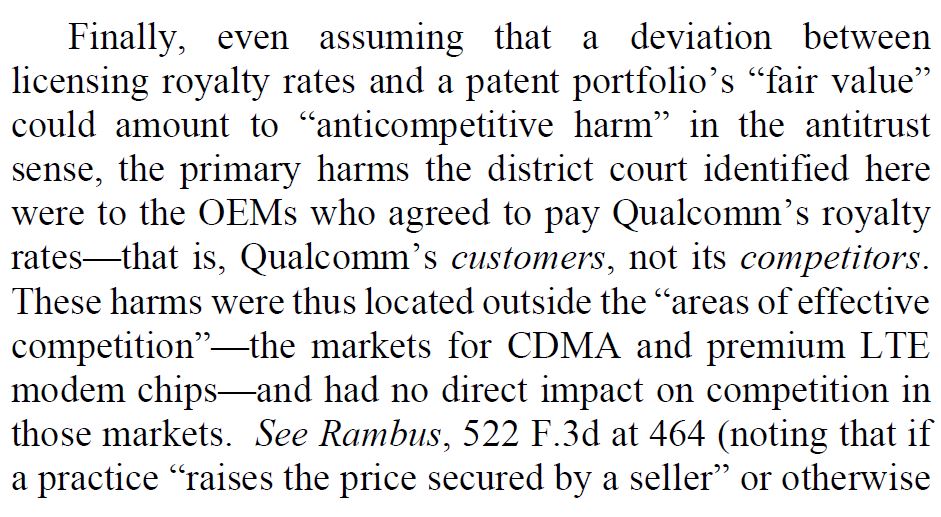Longish thread on CA9 Qualcomm opinion. I think that I agree with the CA9’s big picture analysis, though I find the discussion of antitrust doctrine confused or wrong at various points. (1/)
For me, the big picture here is about ECPR pricing and ensuring that more efficient chip producers can compete with QC even if QC holds the relevant patent rights, as they seem to do. (2/)
As suggested in the opinion, the fear would be that QC would tie its chips to its patents and force OEMs to take chips from QC. They don’t do that. Instead, they license the patents to OEMs (and only to OEMs) and don’t license at the chip level. (3/)
Chip makers get a kind of zero-royalty, we-won’t-sue-you indemnification from QC, but when a non-QC firm sells chips to an OEM, their purchasing OEM need a patent license from QC (4/)
QC’s licensing regime—chip supplier neutrality as the opinion puts it—should mean that a firm better at making chips can undercut QC’s chip prices and the OEM pays a patent licensing fee to QC separately. (5/)
Firms can obviously be better or worse and chip making. See competition between Japanese firms and U.S. firms in the DRAM market in the 1970s/80s. (6/)
Chip makers seems to want direct exhaustion-style licenses but as CA9 notes, U.S. antitrust law imposes few situations where firms have to deal with their competitors. (7/)
QC’s change in royalty pricing seems to have jacked up prices, but U.S. antitrust law is clear that firms get to charge high prices, so that issue seemed like a loser here. (8/)
There are separate questions about whether QC has violated contracts with standard setting organizations—and the CA9 leaves those open--but there doesn’t seem to be the type of behavior that gives rise to antitrust liability. (9/)
So far, so good. But the opinion has this discussion of antirust harm that I just really didn’t get. @ErikHovenkamp has pointed to this as well in his tweets. The discussion floats through the opinion, but take this as an example: (10/)
The cite to Rambus suggests that the new opinion doesn’t stand alone, but I think Rambus didn’t really get that right either. (11/)
When you do monopoly power on day 1 of antitrust, you set out the simple model: MR=MC, prices above what they would be in competition and a reduction in output. The day 1 version of harm. (12/)
The harms there are suffered by two groups of consumers: the consumers who continue to buy at the now higher prices—the overcharge transferred to the monopolist—and the consumers who no longer buy at the higher prices (the dead-weight loss). (13/)
That is where we start with harm in antitrust. We can talk about lost profits by actual or potential competitors but the starting place for antitrust harm is to the direct consumers of the product. (14/)
You could imagine standing questions here and complicated questions of how to do that if Apple v. Pepper is a step on the road to post-Illinois Brick, but harms to purchasers of the product is the starting place for antitrust harm. (15/)
After all of that, I am still not sure exactly how well I understand these markets and I would need to go back and look at the lower court opinion (but not today). (16/16)

 Read on Twitter
Read on Twitter


